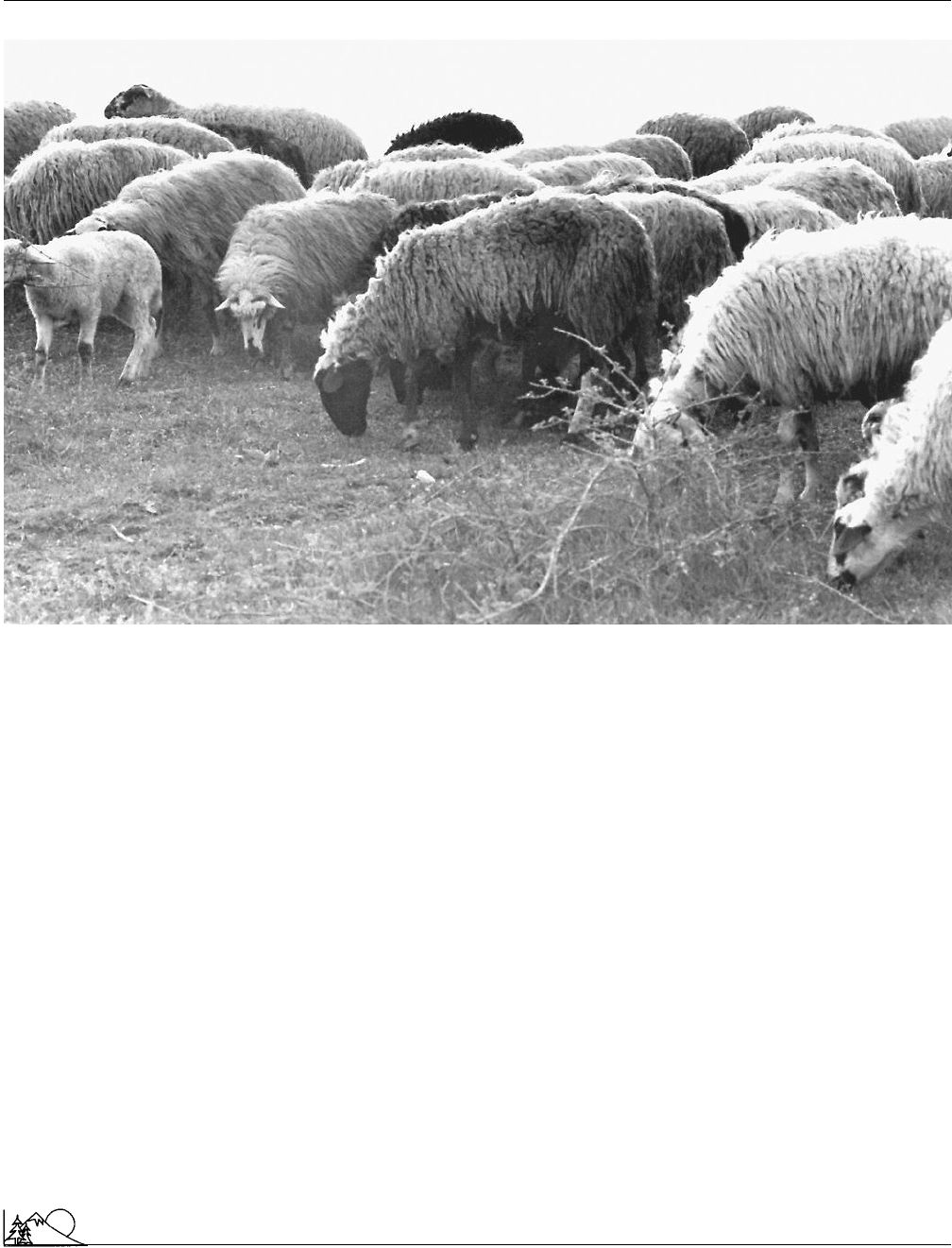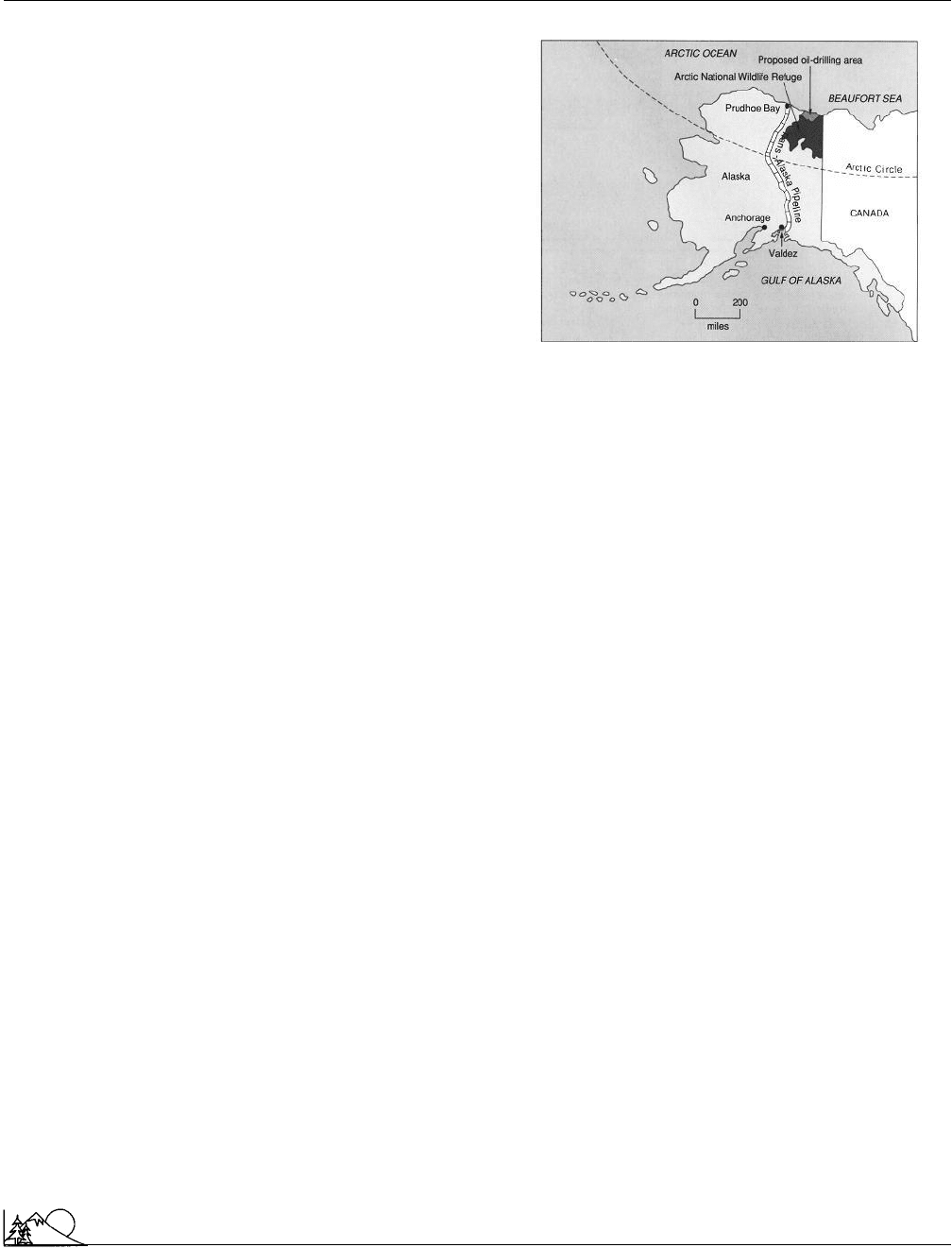Environmental Encyclopedia
Подождите немного. Документ загружается.


Environmental Encyclopedia 3
Trail Smelter arbitration
Overgrazing by domestic animals destroys the grassland and contributes to the tragedy of the commons.
(©Richard Dibon-Smith, National Audubon Society Collection. Photo Researchers Inc. Reproduced by permission.)
Trail Smelter arbitration
The Trail
Smelter
arbitration of 1938 and 1941 was a land-
mark decision about a dispute over
environmental degra-
dation
between the United States and Canada. This was the
first decision to recognize international liability for damages
caused to another nation, even when no existing treaty cre-
ated an obligation to prevent such damage.
A tribunal was set up by Canada and the United States
to resolve a dispute over timber and crop damages caused
by a smelter on the Canadian side of the border. The tribunal
decided that Canada had to pay the United States for dam-
ages, and further that it was obliged to abate the
pollution
.
In delivering their decision, the tribunal made an historic
and often-cited declaration: “Under the principles of interna-
tional law, as well as of the law of the United States, no
State has the right to use or permit the use of its territory
in such a manner as to cause injury by fumes in or to the
territory of another or the properties or persons therein,
when the case is of serious consequence and the injury is
established by clear and convincing evidence...” The case
1417
was landmark because it was the first to challenge historic
principles of international law, which subordinated interna-
tional environmental duty to nationalistic claims of sover-
eignty and free-market methods of unfettered industrial de-
velopment. The Trail Smelter decision has since become
the primary precedent for international
environmental law
,
which protects the
environment
through a process known
as the “web of treaty law.” International environmental law
is based on individual governmental responses to discrete
international problems, such as the Trail Smelter issue. Legal
decisions over environmental disputes between nations are
made in reference to a growing body of treaties, conventions,
and other indications of “state practices.”
The Trail Smelter decision has shaped the core princi-
ple underlying international environmental law. According
to this principle, a country which creates
transboundary
pollution
or some other environmentally hazardous effect
is liable for the harm this causes, either directly or indirectly,
to another country. A much older precedent for this same
principle is rooted both in Roman Law and Common Law:
sic utere ut alienum non laedas—use your own property in

Environmental Encyclopedia 3
Russell Eroll Train
such a manner as not to injure that of another. Prior to
the twentieth century, this principle was not relevant to
international law because actions within a nation’s borders
rarely conflicted with the rights of another. See also Acid
rain; Environmental Law Institute; Environmental liability;
Environmental policy; United Nations Earth Summit
[Kevin Wolf]
Russell Eroll Train (1920 – )
American environmentalist
Concern about environmental issues is a relatively recent
phenomenon worldwide. Until the 1960s, citizens were not
interested in air and
water pollution
, waste disposal, and
wetlands
destruction.
An important figure in bringing these issues to public
attention was Russell Eroll Train. He was born in James-
town, Rhode Island, on June 4, 1920, the son of a rear
admiral in the United States Navy. He attended St. Alban’s
School and Princeton University, from which he graduated
in 1941. After serving in the United States Army during
World War II, Train entered Columbia Law School, where
he earned his law degree in 1948.
Train’s early career suggested that he would follow a
somewhat traditional life of government service. He took a
job as counsel to the Congressional Joint Committee on
Revenue and Taxation in 1948 and five years later, became
clerk of the House Ways and Means Committee. In 1957,
Train was appointed a judge on the Tax Court of the United
States.
This pattern was disrupted, however, because of
Train’s interest in
conservation
programs. In 1961, he
founded the African Wildlife Leadership Foundation and
became its first head. He gradually began to spend more
time on conservation activities and finally resigned his judge-
ship to become president of the Conservation Foundation.
Train’s first environmental-related government ap-
pointment came in 1968, when President Lyndon Johnson
asked him to serve on the National Water Commission. The
election of Republican Richard Nixon late that year did not
end Train’s career of government service, but instead provided
him with even more opportunities. One of Nixon’s first ac-
tions after the presidential election was his appointment of a
20-member inter-governmental task force on
natural re-
sources
and the
environment
. The task force’s report criti-
cized the government’s failure to fund anti-pollution pro-
grams adequately, and it recommended the appointment of a
special advisor to the President on environmental matters.
In January 1969, Nixon offered Train another assign-
ment. The President had been sharply criticized by environ-
1418
mentalists for his appointment of Alaska Governor Walter
J. Hickel as Secretary of the Interior. To blunt that criticism,
Nixon chose Train to serve as Under Secretary of the Interior,
an appointment widely praised by environmental groups. In
his new position, Train was faced with a number of difficult
and controversial environmental issues, the most important
of which were the proposed
Trans-Alaska pipeline
project
and the huge new airport planned for construction in Flori-
da’s
Everglades National Park
. When Congress created
the
Council on Environmental Quality
in 1970 (largely as
a result of Train’s urging), he was appointed chairman by
President Nixon. The Council’s first report identified the
most important critical environmental problems facing the
nation and encouraged the development of a “strong and
consistent federal policy” to deal with these problems.
Train reached the pinnacle of his career in September
1973, when he was appointed administrator of the federal
government’s primary environmental agency, the
Environ-
mental Protection Agency
(EPA). During the three and
a half years he served in this post, he frequently disagreed
with the President who had appointed him. He often felt
that Nixon’s administration tried to prevent the enforcement
of environmental laws passed by Congress. Some of his most
difficult battles involved energy issues. While the administra-
tion preferred a laissez-faire approach in which the market-
place controlled energy use and prices, Train argued for
more controls that would help conserve energy resources
and reduce air and water
pollution
.
With the election of Jimmy Carter in 1976, Train’s
tenure in office was limited. He resigned his position at
EPA in March 1977 and returned to the Conservation Foun-
dation.
[David E. Newton]
R
ESOURCES
B
OOKS
Schoenbaum, E. W. “Russell E. Train.” In Political Profiles. New York:
Facts on File, 1979.
P
ERIODICALS
Durham, M. S. “Nice Guy in a Mean Job.” Audubon (January 1974): 97–104.
Trans-Alaska pipeline
The discovery in March 1968 of oil on the Arctic slope of
Alaska’s Prudhoe Bay ignited an ongoing controversy over
the handling of the Arctic slope’s abundant energy resources.
Of all the options considered for transporting the huge quan-
tities found in North America’s largest field, the least hazard-
ous and most suitable was deemed a pipeline to the ice-free
southern port of Valdez.

Environmental Encyclopedia 3
Trans-Amazonian highway
Plans for the pipeline began immediately. Labeled
the Trans-Alaskan Pipeline System (TAPS) its cost was
estimated at $1.5 billion, a pittance compared to the final
cost of $7.7 billion. The total development cost for Prudhoe
Bay oil was likely over $15 billion, the most expensive
project ever undertaken by private industry. Antagonists,
aided by the nascent environmental movement, succeeded
in temporarily halting the project. Legislation that created
the
Environmental Protection Agency
(EPA) and re-
quired environmental impact statements for all federally-
related projects added new, critically important require-
ments to TAPS. Approval came with the 1973 Trans-
Alaskan Authorization Act, spurred on by the 1973 OPEC
embargo, the world’s first severe energy crisis. Construction
quickly resumed.
The pipeline is an engineering marvel, having broken
new ground in dealing with
permafrost
and mountainous
Arctic conditions. The northern half of the pipeline is
elevated to protect the permafrost, but river crossings and
portions threatened by avalanches are buried for protection.
A system was developed to keep the oil warm for 21
days in the event of a shutdown, to prevent TAPS from
becoming the “world’s largest tube of chapstick.” Especially
notable is Thompson Pass near the southern end, where
descent angles up to 45 degrees severely taxed construction
workers, especially welders.
Everything about TAPS is colossal: 799 mi (1,286
km) of 48-in (122-cm) diameter vanadium alloy pipe;
78,000 support columns; 65,000 welds; 15,000 trucks; and
peak employment of more than 20,000 workers. TAPS
has an operations control center linked to each of the 12
pump stations, with computer controlled flow rates and
status checks every 10 seconds.
The severe restrictions that the enabling act imposed
have paid off in an enviable safety record and few problems.
The worst problem thus far was caused by local sabotage
of an above-ground segment. In spite of its good record,
however, TAPS remains controversial. As predicted, it
delivers more oil than West Coast refineries can handle,
and efforts continue to allow exports to Japan.
In 2001, the Secure America’s Future Energy (SAFE)
Act, based on the President’s National Energy Policy,
stated among its goals the 2004 renewal of the existing
TAPS lease, along with the construction of a new pipeline
to transport
natural gas
from Alaska to the 48 contiguous
states. Another SAFE goal, the development of the
Arctic
National Wildlife Refuge
for
oil drilling
, is still heavily
backed in government despite a resounding Senate rejection
of the project in 2002. Both utilitarian conservationists
and altruistic preservationists are at loggerheads over energy
development in Alaska, while many native Inuits consider
1419
The route of the Trans-Alaska pipeline. (McGraw-
Hill Inc. Reproduced by permission.)
this an opportunity to solidify their growing involvement
in the American economy. See also Oil drilling; Oil embargo
[Nathan H. Meleen]
R
ESOURCES
B
OOKS
Dixon, M. What Happened to Fairbanks? The Effects of the Trans-Alaska
Oil Pipeline on the Community of Fairbanks, Alaska. Boulder: Westview
Press, 1978.
Roscow, J. P. 800 Miles to Valdez: The Building of the Alaska Pipeline.
Englewood Cliffs, NJ: Prentice Hall, 1977.
P
ERIODICALS
Hodgson, B. “The Pipeline: Alaska’s Troubled Colossus.” National Geo-
graphic 150 (November 1976): 684–707.
Lee, D. B. “Oil in the Wilderness: An Arctic Dilemma.” National Geographic
174 (December 1988): 858–871.
Trans-Amazonian highway
The Trans-Amazonian highway begins in northeast Brazil
and crosses the states of Para and Amazonia. The earth
road, known as BR-230 on travel maps, was completed in
the 1970s during the military regime that ruled Brazil from
1964 until 1985. The highway was intended to further
land
reform
by drawing landless peasants to the area, especially
from the poorest regions of northern Brazil. More than
500,000 people have migrated to Transamazonia since the
early 1970s. Many of the colonists feel that the government
enticed them there with false promises.
The road has never been paved, so it is nothing but
dust in the dry season and an impassable swamp during the
wet season. Farmers struggle to make a living, with the
highway as their only means of transporting produce to

Environmental Encyclopedia 3
Transboundary pollution
market. When the rains come, large segments of the highway
wash away entirely, leaving the farmers with no way to
transport their crops. Small farmers live on the brink of
survival. Farmer Jose
´
Ribamar Ripardo says, “People grow
crops only to see them rot for lack of transport. It’s really
an animal’s life.” To survive in Amazonia, the colonists say,
they require a paved road to transport their produce.
The goal of repairing and paving the highway is viewed
with disfavor by many environmentalists. Roads through
Amazonia are perceived as being synonymous with destruc-
tion of the rain forests. Many environmental groups fear
that improved roads will bring more people into the area
and lead to increased devastation.
The Movement For Survival, spearheaded by Jose
´
Ger-
aldo Torres da Silva, claims that “If farmers could have techni-
cal help to invest in
nature
, they will be able to support their
families with just one third of their land lots, avoiding
defor-
estation
, the indiscriminate killing of numerous animal and
plant species.” Farmers in the region say that they can survive
on the land base that they have already acquired. They have
proposed preserving some natural vegetation by growing a
mixture of
rubber
and cacoa trees, which grow best in shaded
areas, so they will not have to devastate the forest. Efforts
are currently underway to establish extractivist preserves to
harvest rubber, brazil nuts, and other native products. Such
proposals for the use of the forest are a viable option, but they
are not enough. The environmentally friendly plans must also
take into account fluctuations in the market place. Brazil nuts,
for instance, are harvested in the unspoiled forest. When nut
prices fall onthe international market, the gatherers must have
other means of income to fall back on, without having to relo-
cate to a different part of the country.
Many residents of the area fear that if small farmers
do not have a reliable road to get produce to market, they
will have to leave the region. There is a real danger that
their lots will be sold to cattle ranchers, loggers, and invest-
ors. Small farmers have a track record of utilizing the land
in ways that are more environmentally sound than those
who follow in their wake.
[Debra Glidden]
R
ESOURCES
P
ERIODICALS
Babbitt, B. E. “Amazon Grace.” New Republic 202 (25 June 1990): 18–19.
Fearnside, P. M. “Rethinking Continuous Cultivation in Amazonia: The
‘Yurimaguas Technology’ May Not Provide the Bountiful Harvest Predicted
by its Originators.” Bioscience 37 (March 1987): 209.
Ne
´
to, R. B. “The Transamazonian Highway.” Buzzworm 4 (November-
December 1992): 28–29.
Simpson, J. “To the Beginning of the World.” World Monitor 6 (January
1993): 34–41.
1420
Vesilind, P. J. “Brazil Moment of Promise and Pain.” National Geographic
171 (March 1987): 372–373.
Transboundary pollution
The most common interpretation of transboundary
pollu-
tion
is that it is pollution not contained by a single nation-
state, but rather travels across national borders at varying
rates. The concept of the global commons is important to
an understanding of transboundary pollution. As both popu-
lation and production increase around the globe, the poten-
tial for pollution to spill from one country to another in-
creases. Transboundary pollution can take the form of
contaminated water or the deposition of airborne pollutants
across national borders. Transboundary pollution can be
caused by catastrophic events such as the Chernobyl nuclear
explosion. It can also be caused by the creeping of industrial
discharge
that eventually has a measurable impact on adja-
cent countries. It is possible that pollution can cross state
lines within a country and would indeed be referred to as
transboundary pollution. This type of case is seldom held
up as a serious policy problem since national controls can
be brought to bear on the responsible parties and problems
can be solved within national borders. It is good to under-
stand how interstate environmental problems might develop
and to have knowledge as to those regulatory units of national
government that have jurisdiction.
Federalism is important in issues of national environ-
mental pollution largely because pollution can spread across
several states before it is contained. Within the United
States, it is the
Environmental Protection Agency
(EPA)
that writes the regulations that are enforced by the states.
The general rule is that states may enact environmental
regulations that are more strict than what the EPA has
enacted, but not less strict. In some cases interstate compacts
are designated by the EPA to deal with issues of
pollution
control
. An example of this is the regional compacts for
the management of low level
radioactive waste
materials.
These interstate compacts meet and make policy for the
siting and management of facilities, the transport of materials
and the long term planning for adequate and safe storage
of
low-level radioactive waste
until its
radioactivity
has
been exhausted. Other jurisdictions such as this in the U.S.
deal with transboundary issues of
air quality
,
wildlife man-
agement
, fisheries,
endangered species
,
water quality
,
and solid
waste management
. Federalism has been mani-
fested in specific legislation. The
National Environmental
Policy Act
(NEPA) is an attempt to clarify and monitor
environmental quality regardless of state boundaries. NEPA
provides for a council to monitor trends. The
Council on
Environmental Quality
is a three-member council ap-
pointed by the President of the United States to collect data

Environmental Encyclopedia 3
Transboundary pollution
at the national level on environmental quality and manage-
ment, regardless of jurisdiction. This picture at a national
level is vastly complicated when moved to a global level.
There is increasing demand for dialogue and support
for institutions that can address impacts on the global com-
mons. The issue of “remedies” for transboundary pollution
is usually near the top of the agenda. Remedies frequently
take the form of payments to rectify a wrong, but more often
take the form of fines or other measures to assure compliance
with best practices. The problem with this approach is that
charges have to be high enough to offset the cost of control-
ling “creeping” pollution that might cross national borders
or the cost of monitoring production processes to prevent
predictable disasters.
Marine pollution
is an excellent exam-
ple of a transboundary pollution problem that involves many
nation-states and unlimited point sources of pollution. Ma-
rine pollution can be the result of on-shore industrial pro-
cesses that use the ocean as a waste disposal site. Ships at
sea find the ocean just too convenient as a sewer system,
and surface ocean activities such as
oil drilling
are a constant
source of pollution due to unintentional discharges. Acci-
dents at sea are well-documented, the most famous in recent
years being the
Exxon Valdez
oil spill off of Alaska in
Prince
William Sound
in 1989. Earlier, in 1969 an international
conference on marine pollution was held. As a result of
this conference two treaties were developed and signed that
would respond to oil pollution on the high seas. These
treaties were not fully ratified until 1975. The Convention
on the Prevention of Marine Pollution by Dumping of
Wastes and Other Matter and The Convention for the
Prevention of Marine Pollution by Dumping from Ships and
Aircraft cite specific pollutants that are considered extremely
detrimental to marine environments. These pollutants are
organohalogenic compounds and mercury, as well as slightly
less harmful compounds such as lead, arsenic, copper, and
pesticides. The specificity of those treaties that deal with
ocean environments indicate a rising commitment to the
control of transboundary pollution carried by the ocean’s
currents and helped to resolve the question of remedies in
the Valdez catastrophe.
Acid rain
is a clear example of how air currents can
carry destructive pollution from one nation-state to another,
and indeed, around the globe. Air as a vector of pollution
is particularly insidious because air patterns, although
known, can change abruptly, confounding a country’s at-
tempt to monitor where pollutants come from.
Acid deposi-
tion
has been an international issue for many years. The
residuals from the burning of
fossil fuels
and the byproducts
from radiation combine in the upper
atmosphere
with
water vapor and precipitate down as
acid
rain. This precipi-
tation is damaging to lakes and streams as well as to forests
and buildings in countries that may have little sulfur and
1421
nitrogen
generation of their own. The negative justice of
this issue is that it is the most industrialized nations that
are producing these pollutants due to increased production
and too often the pollution rains down on developing coun-
tries that have neither the resources nor the technical exper-
tise to clean up the mess. Only recently, due to international
agreements between nation-states, has there been significant
reduction in the deposition of acid rain. The
Clean Air Act
Amendments of 1990 in the United States helped to reduce
emissions from coal-burning plants. In Europe, sulfur emis-
sions are being reduced due to an agreement among eight
countries. The European Community in 1992 agreed to
implement
automobile emission standards
similar to
what the United States agreed to in the early 1980s. In 1994
all large automobiles in Europe were required to reduce
emissions with the installation of catalytic converters. These
measures are all aimed at reducing transboundary pollution
due to air emissions.
Probably the most famous case of transboundary river
pollution is that of the Rhine River with its point of incidence
in Basel, Switzerland. This was a catastrophe of great propor-
tions. The source of pollution was an explosion at a chemical
plant. In the process of putting out the fire, great volumes
of water were used. The water mixed with the
chemicals
at the plant (mercury, insecticides, fungicides, herbicides
and other
agricultural chemicals
), creating a highly toxic
discharge. This lethal mixture washed into the Rhine River
and coursed its way to the Baltic Sea, affecting every country
along the way. Citizens of six sovereign nations were affected
and damage was extensive. There was further consternation
when compensation for damage was found to be difficult to
obtain. Although the chemical company volunteered to pay
some compensation it was not enough. It was possible that
each affected nation-state could try the case in their own
national court system, but how would collection for damages
take place? “In transboundary cases, if there is no treaty or
convention in force, by what combination of other interna-
tional law principles can the rules of liability and remedy be
determined?” It becomes problematic to institute legal action
against another country if there is no precedent. Since there
is no history of litigation between nation-states in cases of
environmental damage there is no precedent to determine
outcome. Historically, legal disputes have been resolved (al-
beit, extremely slowly) through negotiations and treaties.
There is no “polluter pays” statute in international law doc-
trine.
The authority that can be brought to bear on issues
of transboundary pollution is weak and confusing. The only
mechanism that is currently available to compensate injury
is private litigation between parties and that is difficult due
to a lack of agreements to enforce civil judgments. If, in
fact, the polluter is the national government, as in the case

Environmental Encyclopedia 3
Transfer station
of the Chernobyl disaster, it may be nearly impossible to
gain compensation for damages.
Transboundary pollution takes many forms and can
be perpetrated by both private industry and government
activities. It is difficult if not impossible to litigate on an
international scale. It is in fact sometimes difficult to deter-
mine who the polluter is when the pollution is “creeping”
and not a catastrophic incidence. Airborne transboundary
pollution is extremely difficult to track due to the pervasive
nature of the practices that produce it. Global solutions to
transboundary pollution can only be successful if all nations
agree to implement controls to reduce known pollutants
and to take responsibility for accidents that damage the
environmental quality of other nations.
[Cynthia Fridgen]
R
ESOURCES
B
OOKS
Buck, S. J. Understanding Environmental Administration and Law. Wash-
ington, DC: Island Press, 1996.
Plater, Z. J. B., R. H. Abrams, and W. Goldfarb. Environmental Law and
Policy: Nature, Law, and Society. St. Paul: West Publishing Co., 1992.
World Wildlife Fund. “Choosing a Sustainable Future: The Report of
the National Commission on the Environment.” Washington, DC: Island
Press, 1993.
P
ERIODICALS
Bernauer, T., and P. Moser. “Reducing Pollution of the River Rhine: The
Influence of International Cooperation in The Journal of Environment &
Development.” Sage Periodicals Press 5, no. 4 (December 1996).
Transfer station
The regional disposal of
solid waste
requires a multi-stage
system of collection, transport, consolidation, delivery, and
ultimate disposal. Many states and counties have established
transfer stations, where solid waste collected from curbsides
and other local sources by small municipal
garbage
trucks
is consolidated and transferred to a larger capacity vehicle,
such as a refuse transfer truck, for
transportation
to a
disposal facility. Typically, municipal garbage trucks have a
capacity of 20 cubic yd (15.3 cubic m) and refuse transfer
trucks may have a capacity of 80–100 cubic yd (61–76.4
cubic m). The use of transfer stations reduces hauling costs
and promotes a regional approach to
waste management
.
See also Garbage; Landfill; Municipal waste; Tipping fee;
Waste stream
Transmission lines
Transmission lines are used to transport electricity from
places where it is generated to places where it is used. Almost
1422
all electricity in North America is generated in fossil-fueled,
nuclear-fueled, or hydroelectric generating stations. These
are located some distance away from the factories, businesses,
institutions, and homes where the electricity is actually used,
in some cases hundreds of miles away, so that the electricity
must be transmitted from the generating stations to these
diverse locations.
Transmission lines are strung between tall, well-spaced
towers and are linear features that appropriate long, narrow
areas of land. Most transmission lines carry a high voltage of
alternating current, typically ranging from about 44 kilovolts
(kV) to as high as 750 or more kV (some transmission lines
carry a direct current, but this is uncommon). Transmission
lines typically feed into lower-voltage distribution lines,
which typically have voltage levels less than about 35 kV
and an alternating current (in North America) of 60 Hertz
(Hz; this is equivalent to 60 cycles of positive to negative
per second), and is usually 50 Hz in Europe.
Electrical fields are generated by transmission lines
(and by all electrical appliances), with the strength of the
field being a function of the voltage level of the current
being carried by the powerline. The flow of electricity in
transmission lines also generates a magnetic field. Electric
fields are strongly distorted by conducting objects (including
the human body), but magnetic fields are little affected and
freely pass through
biomass
and most structures. Electric
and magnetic fields both induce extremely weak electrical
currents in the bodies of humans and other animals. These
electrical currents are, however, several million times weaker
than those induced by the normal functions of certain cells
in the human body.
Transmission lines are controversial for various rea-
sons. These include their poor aesthetics, the fact that they
can destroy and fragment large areas of natural lands or take
large areas out of other economically productive land-uses,
and the belief of many people that low-level health risks are
associated with living in the vicinity of these structures.
Aesthetics of transmission lines
Transmission lines are very long, tall, extremely promi-
nent linear features. Transmission lines have an unnatural
appearance and their very presence disrupts the visual aes-
thetics of natural landscapes, as viewed from the ground or
the air. As such, transmission lines represent a type of “visual
pollution” that detracts from otherwise pleasing natural or
pastoral landscapes. These aesthetic damages are an impor-
tant environmental impact of almost all rural transmission
lines. Similarly, above-ground transmission lines in urban
and suburban areas are not regarded as having good aes-
thetics.
Damages to natural values
Apart from difficult crossings of major rivers and
mountainous areas, transmission lines tend to follow the

Environmental Encyclopedia 3
Transmission lines
shortest routes between their origin and destination. Often,
this means that intervening natural areas must be partially
cleared to develop the right-of-way for the transmission line.
This can result in permanent losses of natural
habitat
,as
typically happens when forests are cleared to develop a pow-
erline right-of-way. Moreover, it is not feasible to allow trees
to regenerate beneath a transmission line because they can
interfere with the operation and servicing of the powerline.
For these reasons, vegetation is cleared beneath and
to the sides of transmission lines (for a width of about
one tree-height). This can be done by periodically cutting
shrubby vegetation and young trees or by the careful use of
herbicides, which can kill shrubs and trees while allowing
the growth of grasses and other herbaceous plants.
These sorts of management practices result in the con-
version of any original, natural habitats along a transmission
right-of-way into artificial habitats. The ecological effects
include a net loss of natural habitats and fragmentation
of the remainder into smaller blocks. In addition, roads
associated with the construction and maintenance of trans-
mission lines may provide relatively easy access for hunters,
anglers, and other outdoor recreationalists to previously re-
mote and isolated natural areas. This can result in increased
stress for certain wild
species
, especially hunted ones, as
well as other ecological damages.
Some studies of transmission lines have found that
hypothesized ecological damages did not occur or were un-
important. For example, naturalists suggested that the con-
struction of extensive hydroelectric transmission lines in the
boreal forest of northern Quebec would impede the move-
ments of woodland caribou. In fact, this did not occur, and
caribou were sometimes observed to use the relatively open
transmission corridors during their migrations and as resting
places. Similar observations have been made elsewhere for
moose, white-tailed deer, and other ungulates. Predators of
these animals, such as
wolves
and coyotes, will also freely
move along transmission corridors, unless they are frequently
disturbed by hunters, recreationalists, or maintenance crews.
Certain birds of prey, particularly osprey, may use
transmission poles or pylons as a platform upon which to
build their bulky nests, which may be used for many years. In
some cases the birds are considered a management problem,
especially if their nests get large enough to potentially short
out the powerlines or if the parent birds aggressively defend
their nests against linesmen attempting to repair or maintain
the transmission line. Fortunately, it is relatively easy to
move the nests during the nonbreeding season and to place
them on a “dummy” pole located for the purpose beside the
transmission line. In most cases, the ospreys will readily use
the relocated nest in subsequent years.
Transmission lines also pose lethal risks for certain
kinds of birds, especially larger species that may inadvertently
1423
collide with wires, severely injuring themselves. There have
also been cases of raptors and other large birds being electro-
cuted by settling on transmission lines, particularly if they
somehow span adjacent wires with their wings.
Disruption of land-use
Some economically important land-uses can occur be-
neath transmission lines, for example, forestry and some
types of agriculture. Other land-uses, however, are not com-
patible with the immediate proximity of high-voltage trans-
mission lines, particularly residential land-uses. In cases of
land-use conflicts, opportunities are lost to engage in certain
economically productive uses of the land, a context that
detracts from benefits that are associated with the construc-
tion and operation of the transmission line.
Many people, including some highly qualified scien-
tists, believe that low-level health risks may be associated
with longer-term exposures to the electric and magnetic
fields that are generated by transmission lines. These in-
creased risks mean that people living or working in the
vicinity of these industrial structures may have an increased
risk of developing certain diseases or of suffering other dam-
ages to their health.
Although people are routinely exposed to electromag-
netic fields through the operation of electrical appliances in
the home or at work, those exposures are typically intermit-
tent. In contrast, continuous electromagnetic fields are gen-
erated by transmission lines, so longer-term exposures can
be relatively high. It must be understood, however, that the
scientific knowledge in support of the low-level health risks
associated with transmission lines is incomplete and equivo-
cal and therefore highly controversial.
In particular, some studies have suggested that long-
term exposure to electromagnetic fields generated by high-
voltage transmission lines may be associated with an elevated
incidence of certain types of cancers. The strongest sugges-
tions have been for increased risks of childhood
leukemia
.
There is weaker evidence of increased risks of cancers of the
lymphatic and nervous systems and of adult leukemia. It
must be remembered, however, that not all epidemiological
studies of transmission lines have reported these statistical
relationships and that the increased risks are rather small
when they are found. Studies have also been made of possible
increases in the incidences of migraine headaches, mental
depression, and reproductive problems associated with
longer-term exposures to electromagnetic fields near trans-
mission lines. The results of these studies are inconsistent
and equivocal.
Some researchers who have assessed the medical prob-
lems potentially associated with high-voltage transmission
lines have concluded that it would be prudent to not have
people living in close proximity to these industrial structures.
Even though there is no strong and compelling evidence that

Environmental Encyclopedia 3
Transpiration
medical problems are actually occurring, the precautionary
approach to environmental management dictates that the
potential risks should be avoided to the degree possible. It
would therefore be sensible for people to avoid living within
about 54.5 yd (50 m) or so of a high-voltage transmission
line, and they should avoid frequently using the right-of-
way as travel corridors.
[Bill Freedman Ph.D.]
R
ESOURCES
B
OOKS
Carpenter, D. O., and S. Ayrapetyan. Biological Effects of Electric and Mag-
netic Fields. Vols.1&2.SanDiego: Academic Press, 1994.
Levallois, P., and D. Gauvin. Risks Associated with Electromagnetic Fields
Generated by Electrical Transmission and Distribution Lines. Great Whale
Environmental Assessment: Background Paper No. 9, Part 1. Montreal,
PQ: Great Whale Public Review Support Office. 1994.
P
ERIODICALS
Alonso, J. C., J. A. Alonso, and R. Munoz-Pulido. “Mitigation of Bird
Collisions with Transmission Lines through Ground-wire Marking.” Biol-
ogy Conservation 67 (1994): 129–134.
Coleman, M. P., et al. “Leukemia and Residence Near Electricity Transmis-
sion Equipment: A Case-control Study.” British Journal of Cancer 60 (1989):
793–798.
Feychting, M., and A. Ahlbom. “Magnetic Fields and Cancer in Children
Residing Near Swedish High-voltage Power Lines.” American Journal of
Epidemiology 138 (1993): 467–481.
London, S. J., et al. “Exposure to Residential Electric and Magnetic Fields
and Risk of Childhood Leukemia.” American Journal of Epidemiology 134
(1991): 923–927.
Steenhof, K., M. A. Kochert, and J. A. Roppe. “Nesting by Raptors and
Common Ravens on Electrical Transmission Line Towers.” Journal of
Wildlife Management, 57 (1993): 271–281.
Transpiration
Transpiration is the process by which plants give off water
vapor from their leaves to the
atmosphere
. The process is
an important stage in the water cycle, often more important
in returning water to the atmosphere than is evaporation
from rivers and lakes. A single acre of growing corn, for
example, transpires an average of 3,500 gal (13,248 l) of
water per acre (0.4 ha) of land per day. Transpiration is,
therefore, an important mechanism for moving water
through the
soil
, into plants, and back into the atmosphere.
When plants are removed from an area, soil retains more
moisture and is unable to absorb rain water. As a conse-
quence,
runoff
and loss of nutrients from the soil is likely
to increase. See also Erosion; Flooding; Soil conservation;
Soil fertility
1424
Transportation
For several million years, humans got to where they wanted
to go by one means: walking. This, of course, greatly limited
the distance of travel and the amount of items that could
be transported. Today, transportation is accomplished in the
air, on land, and in water. It ranges from carts pulled by
horses or oxen and dirt roads in Africa to the Concorde
supersonic airplane that can travel from Paris to New York
in four hours.
The first changes in transportation came about five to
six thousand years ago in three areas: the introduction of
boats, the domestication of wild horses, and the invention
of the wheel. Horse domestication started about 6,000 years
ago, probably occurring in several different parts of the world
at about the same time. Riding astride the horse may have
begun in Turkestan before 3,000
B.C.
At about the same
time, many historians believe the wheel was invented in
Mesopotamia, a development that drastically changed the
way people moved about. It was not long before the wheel
found its way onto platforms, forming carts that could be
drawn by horses or oxen. Covered wagons and carriages
soon followed. It is difficult to say when boats became a
means of transportation but ships can be traced back at least
to the ancient Mesopotamian, Greek, Roman, and Egyptian
empires
In ancient Egypt, the main transportation corridor was
the Nile River, where ships carried people and trading goods
through the empire. On land, transportation was more diffi-
cult. Ordinary people traveled by foot, while high nobles
were carried in chairs or covered litters. Over times, these
became more elaborate, requiring as many as 28 people to
carry them. Lower ranking nobles often rode on a chair
fastened on the backs of donkeys. Horse-drawn chariots first
appeared in Egypt about 3,500 years ago.
Wheeled vehicles were first used primarily as hearses
for the great and as military adjuncts until they gradually
came to be used more for carriers of goods. Even during
the Classical Age in Greece, chariots were declining in im-
portance for warfare, and they were finally used only for
sport. In early times carts with shafts for single animals were
preferred in outlying countries where roads were poor, but
with improvement in roads came heavy wagons and the use
of several animals for power.
Ships took on an ever increasingly important role in
transportation starting about
A.D.
1400, when ships of explo-
ration sailed from Europe to Asia and the New World. By
the seventeenth century, ships regularly carried European
settlers to North America. These settlers soon began build
their own transportation system, using boats on rivers and
coastal waterways and horse and cart by land.

Environmental Encyclopedia 3
Transportation
From 1600 to 1754 travel between the American colo-
nies was accomplished most quickly and easily by boat. Ev-
erywhere in colonial America settlements sprang up first
near navigable rivers. Two types of river vessel were common
along colonial rivers. Dugout canoes carried small cargoes,
while long (up to 40 ft [12 m]), flat-bottomed boats handled
larger loads. River travel everywhere in America was slow
and dangerous. Nevertheless, rivers served colonists every-
where as routes for their goods, travel, and communication.
Land travel between seventeenth-century colonies
could be difficult as well. The number and condition of
roads varied widely from colony to colony, depending heavily
on the density of settlement and the support provided by
the various colonial legislatures. In many places roadbeds
were poor and bridges few. By the 1760s one of the longest
roads, the Great Wagon Road, stretched nearly 800 mi
(1,287 km) along old Indian trails through western Pennsyl-
vania and Virginia’s Shenandoah Valley to Georgia. The
longest road in North America was the Camino Real, which
connected Mexico City to Santa Fe, an 1,800-mi (2,897-
km) trip that took wagon trains six months to complete.
Aside from walking and riding a horse, a person in
eighteenth-century America had other means of traveling.
Farmers used two-wheeled carts while Indian traders fre-
quently had packhorses. During this era, the Conestoga
wagon came to the forefront. A high-wheeled vehicle with
a canvas cover, it had a curved bottom in order to keep its load
from shifting. As may be expected, the Conestoga quickly
became popular. By the 1770s more than 10,000 were in
use in Pennsylvania while in the South Carolina backcountry
there were an estimated 3,000. Several stagecoach lines oper-
ated between all the major cities in the north. The most
heavily traveled route, between New York and Philadelphia,
was served twice weekly by a stagecoach.
The 1800s saw the advent of two more means of
transportation: the steamboat and the railway. Hundreds of
steamboats once navigated rivers in the eastern half of the
United States railways caught on throughout the world and
are the primary form of inner-city
mass transit
in many
countries, such as India. In the twentieth century, two more
forms of transportation came into existence: the
automobile
and airplane. The electric streetcar also gained in popularity,
finding itself in many major American cities, including San
Francisco, Los Angeles, and New Orleans.
In many parts of the world today, mass transit systems
are an important component of a nation’s transportation
system. Where people can not afford to buy automobiles,
they depend on bicycles, animals, or mass transit systems
such as bus lines to travel within a city and from city to city.
In the United States the automobile is the primary
form of transportation. It is less important in most other
parts of the world. Mass transportation, or mass transit,
1425
does play a role in the United States. One could argue
that stagecoaches were the first mass transit vehicles in the
country, since they could hold eight to 10 passengers, a big
improvement over one person on a horse or several people
in a small horse-drawn buggy. In the twentieth and twenty-
first centuries, the horse has been replaced with the automo-
bile. Today, mass transit options include airplanes, buses,
trolleys, rail and light rail, and subways. The world’s first
subway opened in London in the late nineteenth century,
soon followed by America’s first subway in New York.
Most of these forms of transportation brought with
them problems, including harming the
environment
. Elec-
tric trains, trolleys, and streetcars are essentially pollution-
free but it takes addition
power plants
to run them, plants
that often use highly polluting fuels such as
coal
and oil.
Autos, buses, and airplanes are mostly oil-dependent. It was
not until the 1970s that the public began to be concerned
with the toxic effects of emissions from these transportation
conveyances. Since then, airplanes, buses, and autos have
increasingly become less polluting. This, however, has been
offset by an increase in their numbers.
Mass transit usage reached its peak in the United
States in the 1940s and 1950s. During the 1960s mass transit
systems and their ridership declined drastically even as urban
populations grew. There was a brief resurgence in the 1970s
as the price of
gasoline
skyrocketed. In 1972, the country
embarked on a round of new mass transit systems when
the Bay Area Rapid Transit (BART), opened in the San
Francisco Bay Area. BART was followed in the next two
decades by new subway, bus, light rail, and trolley systems
in Washington, D.C., San Diego, Atlanta, Baltimore, Los
Angeles, San Jose, California, and other urban areas. At
about the same time, the United States Congress gave the
nation’s inner-city passenger rail system, Amtrak, a new lease
on life. Amtrak proved to be a huge success among inner-
city passengers, but the federal government has never main-
tained the consistent support of the system it showed during
the aftermath of the
petroleum
price hikes of the 1970s.
Over the next several decades, urban planners see little
likelihood of entirely new types of mass transportation.
Rather, they expect improvements over existing bus, trolley,
and light rail systems. And at least one idea that has been
around for 50 years is getting a new look. When the monorail
was introduced at Disneyland in California in 1955, it was
hailed as the clean, fast, and efficient transit system of the
future. Up until now, it never caught on, other than a very
short single-line monorail that opened in Seattle in 1962.
But urban planners are taking a fresh look at monorails,
which are attractive because they could be built above existing
highways. Las Vegas has begun building a $650 million
monorail. The four-line will parallel the heavily congested

Environmental Encyclopedia 3
Tributyl tin
main thoroughfare, the Strip, carrying an estimated 19 mil-
lion passengers when it opens in 2004.
[Ken R. Wells]
R
ESOURCES
B
OOKS
Lewis, David, and Fred Laurence Williams. Policy and Planning as Public
Choice: Mass Transit in the United States. Burlington, VT: Ashgate Publish-
ing Co., 1999.
P
ERIODICALS
Brovarski, Edward. “Getting Around in the Old Kingdom.” Calliope (Sep-
tember 2001): 19.
Gould, Lark Ellen. “Making Tracks: Las Vegas is Preparing for a Well-
Needed Monorail System That Will Move People From Hotel to Hotel.”
Travel Agent (March 4, 2002): SS6–SS7.
National Geographic Society. “Cleaner Living and Driving.” National Geo-
graphic (May 2001): XIV.
National League of Cities. “Technology Improves City Transportation
Flow, Safety.” Nation’s Cities Weekly (July 3, 2000): 5.
Reynolds, Francis D. “The Transportation System of The Future.” The
Futurist (September 2001): 44.
O
RGANIZATIONS
U.S. Department of Transportation, 400 7th Street NW, Washington, DC
USA 20590 202-366-4000, Email: dot.comments@ost.dot.gov, <http://
www.transportation.gov>
Trash
see
Solid waste
Treespiking
see
Monkey-wrenching
Tributyl tin
Tributyl tin (TBT) is a synthetic organic tin compound that
is primarily used as an additive to paints. In this application,
TBT acts as a biocide or compound that kills plants such
as algae, fungus, mildew, and mold that grow in or on the
surface of the coating. These antifouling paints, as they are
called, are applied to the hulls of ships to prevent sea life
(e.g., barnacles and algae) from attaching to the hull. Growth
of organisms on the hulls of ships causes ships to slow down
and increases fuel consumption due to increased drag. Ships
that are covered with these organisms can also transport
non-native, or invasive,
species
around the world, which
can disrupt an
ecosystem
and cause reductions in biological
diversity. TBT is also used in lumber preservatives as an
industrial biocide.
TBT-based paints were introduced more than 40 years
ago. The first TBT anti-fouling paints, known as Free Asso-
1426
ciation Paints (FAPs), where the TBT is mixed into the
paint, prevented fouling by uncontrolled
leaching
of TBT
into the
environment
. Starting 20 years ago, FAPS were
gradually phased out and replaced with TBT Self Polishing
Copolymer Paints, in which the TBT is bound in the paint
matrix. This type of formulation allows for TBT to be re-
leased slowly and uniformly.
TBT, also known as organotin, is a widespread con-
taminant of water and sediments in harbors, shipyards, and
waterways. TBT is persistent in marinas, estuaries, and other
waters where circulation is poor and flushing irregular. In the
natural aquatic environment, degradation of TBT through
biological processes is the most important pathway for the
removal of this toxic compound from the water column. At
levels of TBT contamination typical of contaminated surface
waters, the
half-life
is six days to four months. Half-life
refers to the amount of time it takes for one-half of the
TBT to be eliminated from the environment through natural
means.
TBT has been shown to have significant environmen-
tal impact and is considered to be an endocrine disruptor
that affects the immune and reproductive systems. In mol-
luscs, TBT can be found in concentrations that are up to
250,000 times higher than in the surrounding
sediment
or
seawater. Contaminated molluscs had deformed shells, slow
growth rates, and poor reproduction, with eggs and larvae
often dying. Exposure to TBT has resulted in sex change
and infertility in at least 50 species of snails. In the dogwhelk,
which is a small marine snail, TBT causes the female snail
to grow a penis that blocks the oviduct and thus prevents
reproduction. This abnormality is referred to as “imposex,”
and its development has been linked to the concentrations
of TBT in tissue. Because of this association, imposex in
the dogwhelk has been used as an indicator of TBT
pollu-
tion
. TBT has also been detected in large predators such
as
sharks
,
seals
, and
dolphins
, indicating that TBT can
accumulate in the food chain, as larger animals eat smaller
animals contaminated with TBT. Currently, not enough
data are available to help researchers determine whether
TBT is a human
carcinogen
, so the U.S.
Environmental
Protection Agency
(EPA) has assigned it to the “cannot
be determined” category.
Environmental concerns over the effects of TBT-
based paints has led to the regulatory control of TBT
throughout the world. In 1988, the United States enacted
the Organotin Antifouling Paint Control Act that restricts
the use of TBT-based antifoulants to ships larger than 25
meters in length or those with
aluminum
hulls. The Act
also restricted the release rate of TBT from the antifouling
paints. In 1990, the International Maritime Organization
(IMO) of the United Nations’ Marine Environment Protec-
tion Committee adopted a resolution that recommended
